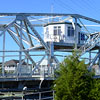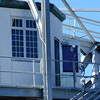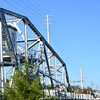Little River Village and Historic Driving Tour
One of the oldest coastal communities in South Carolina, Little River attracted English colonists as early as the 1730s. Today it is best known for its local seafood and access to the Intracoastal Waterway.
Photo Gallery
Click icon to enlarge image. Use arrow keys or
click large picture to cycle through the gallery.
|
Little River Village and Historic Driving Tour
Itinerary
Add This Site to Your Itinerary
Site Description
Archaeological work on Waites Island near Little River has revealed oyster shell mounds believed to have been constructed by Pre-Columbian Indians who predate the historic tribes of the area. Tracing its recorded history back to 1733, the village of Little River is one of the oldest settlements in South Carolina. Much like Murrells Inlet which bookends Horry County to the South, Little River and its waterfront were instrumental in the development of timber and naval stores industry in South Carolina's early days. In 1733, an English colonist, Thomas Ash, was given a land grant in Little River and opened an inn off what would become King's Highway, halfway between the Cape Fear River settlements and Georgetown.
Tours and Events
The famed English evangelist George Whitefield who helped launch America's Great Awakening, visited Ash's inn in 1740 and marveled at the beauty of the nearby beaches. "At break of day," he noted in his journal, "we mounted our horses, and, I think, never had a more pleasant journey. For nearly twenty miles we rode over a beautiful bay as plain as a terrace walk, and as we passed along were wonderfully delighted to see the porpoises taking their pastime, and hear, as it were, shore resounding to shore the praises of Him Who hath set bounds to the sea....". George Washington also noted "the long bay" that would become the Grand Strand's popular beaches as he passed through Little River on his Southern Tour in 1791. Also likely passing through the region were Colonial Era pirates such as Blackbeard, Captain Kidd and Stede Bonnett, drawn to the region because of Little River Inlet and nearby creeks which provided easy sites to hide their ships and replenish drinking water. The nearby river that gives the village and the inlet their names flows into the Atlantic along the border of North and South Carolina, although it is now largely absorbed by the Intracoastal Waterway. In the Colonial Era, a bustling trade in timber and naval stores made Little River one of the busiest communities in the region and rivaled farming as a source of income for locals. Little River was the first community to receive news of the opening fire of the Revolutionary War at Lexington and Concord in 1775, when a dispatch rider arrived at the Boundary House, the home of Isaac Marion, a brother of Brigadier General Francis Marion. The Little River area was a seat of Patriot support during the Revolution. It was also a local center for Southern blockade runners during the Civil War, when Federal warships patrolled the coast to prevent shipping in and out of South Carolina. To defend the port of Little River, Confederate forces built Fort Randall, an earthen artillery battery which is located today on private property at Tilghman Point. In 1862, Federal sailors from the USS Monticello landed near Little River and destroyed two nearby salt works. In 1863, the famous Northern naval commando, Lieutenant William Cushing, led a Federal naval raid against Fort Randall, and in 1865, a landing party of Federal seamen raided Little River and destroyed a large store of cotton. In the late 19th century and into the early 20th century, the timber industry remained important to the Little River area, although more local residents were engaged in sharecropping and tobacco and cotton farming. As river traffic decreased at river ports like Conway in the early 20th century, the docks at Little River remained busy. As the tourism industry expanded on the Grand Strand in the 1950s, Little River gained fame for its local seafood fisheries and seafood restaurants. It remains a popular spot for pleasure boating and access to the Intracoastal Waterway. Numerous privately-owned historic homes from the late 19th and early 20th centuries still stand in Little River, along with several historic churches, cemeteries, the Little River Swing Bridge over the Intracoastal Waterway, and a rare, existing stretch of the Colonial-Era King's Highway at Vereen Memorial Historical Gardens. The Boundary House which no longer exists, is noted by a state historical marker, adjacent to the southbound lane of U.S. 17, near Graystone Boulevard. A map for a driving tour of Little River is available through the Horry County Board of Architectural Review and may be downloaded at the website link above. Guided Tours: Self
|




